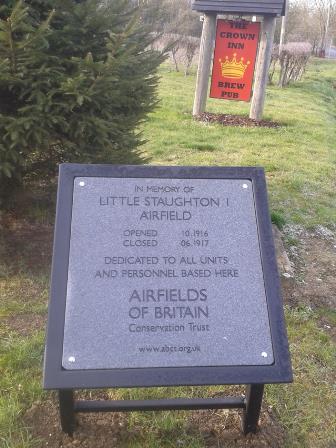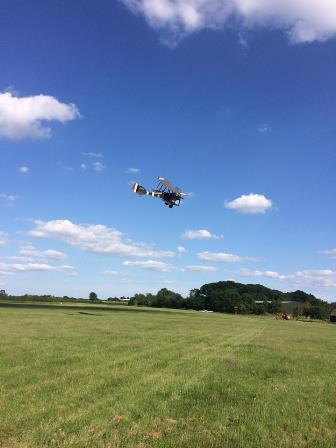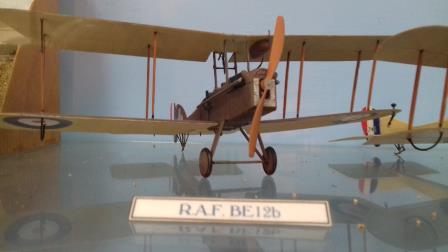Little Staughton Airfield
This article was written by Jeanette Atkinson and Brenda Foster with the help of the staff at the Shuttleworth Collection.
Little Staughton 1
Little Staughton is home to the site of an airfield/landing strip that was used in World War One by the early pilots and fighter planes of The Royal Flying Corps (RFC). Royal Aircraft Factory BE2 and BE12 variant fighters of No 75 Squadron had the Little Staughton 1 airfield available to them as a Home Defence Night Landing Ground. This landing ground operated from 1 October 1916 to the middle of July 1917 and a plaque commemorating this fact can now be found at the entrance to The Crown Public House on Green End. There were no permanent buildings on this landing strip (one of 140 available in the UK), just tents! Due to the short flying range of the planes of the times, emergency Night Landing Grounds were essential.
This early airfield lay to the north-west of the later and more famous airfield that operated in World War II, which is now based in Cambridgeshire. The exact site of Little Staughton 1 is on arable land opposite The Kangaroo/Rectory Farm Cottages and it would have been a level grass field. The site location can be seen on the Airfields of Britain Conservation Trust website.

Squadron 75
Squadron 75, RFC was formed on 1st October 1916 as a Home Defence Unit at Goldington, Bedford; 75 Squadron, part of the Home Defence Wing Southern, was based at Yelling (St.Neots), with detachments at Old Weston (Thrapston) and Therfield (Baldock). The planes flown by these squadrons were providing defence against the German Zeppelins (hot air balloons that carried bombs) and later against the bombers, mainly Gothas. The Gotha raids started at the end of May 1917 and at this time Squadron 75 was moved east to Elmswell north of Ipswich and Little Staughton was decommissioned.
In World War One, 75 squadron flew The Royal Aircraft Factories BE2c/d/e; BE12, BE12b; Sopwith Camel, 504K, and F2b; the squadron eventually disbanded in Jun 1919. This squadron was later reformed in April 1940 as a Lancaster bomber squadron and was eventually transferred to the New Zealand Airforce in 1945. [Sources: RAF-Lincolnshire.info and Lancaster & Manchester Bomber Archive]
The Biplanes
The BE planes were designed by Geoffrey de Havilland who was later the founder of the De Havilland Aircraft Company. A replica but totally authentic BE2e (shown below) can be seen at the Stow Maries Great War Aerodrome at Maldon in Essex () and this biplane sometimes flies in the summer at the air shows at Shuttleworth, Old Warden, Bedfordshire (www.shuttleworth.org/airshows).

Replica BE2e biplane

Replica BE2e in flight
The Sopwith Camel and the F2b can also be seen in the Shuttleworth Collection.

A model of a BE2c (courtesy of the Shuttleworth Collection)

A model of a BE12b (courtesy of the Shuttleworth Collection)
Biplane Classification
The 'B' Class, or Blériot biplanes, were a standard piston engined aircraft with the propeller in front of the main wing and a small tail at the rear. They were later denoted BE (Blériot Experimental) general purpose tractor biplanes! (http://www.historyofwar.org/articles/company_royal_aircraft_factory.html).
For those interested in these biplanes, articles can be found here:
Books on WW1 and the RFC/RAF of interest are:
- The Air Defence of Britain 1914-1918, Cole &Cheesman (Putnam 1984)
- The Royal Flying Corp in World War One, RL Rimmel
(Arms and Armour Press, 1985)
- RAF Squadrons, CG Jefford (Airlife 1988)